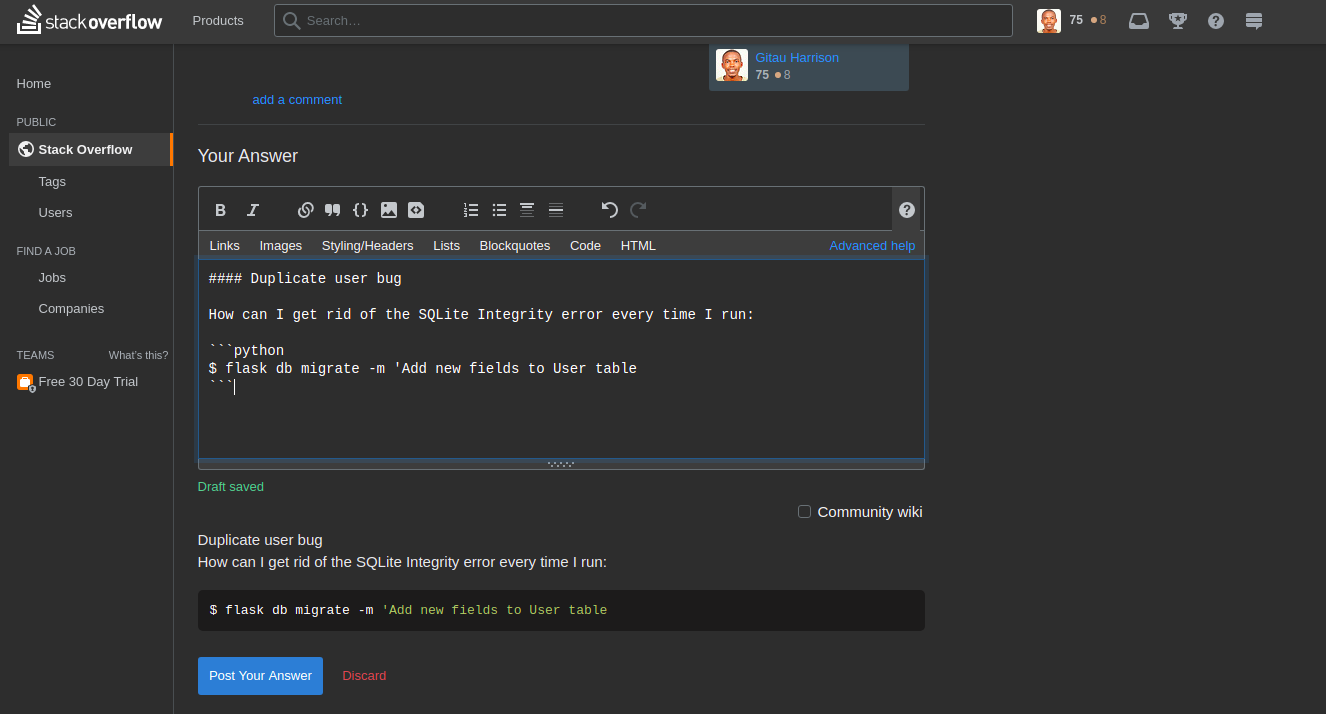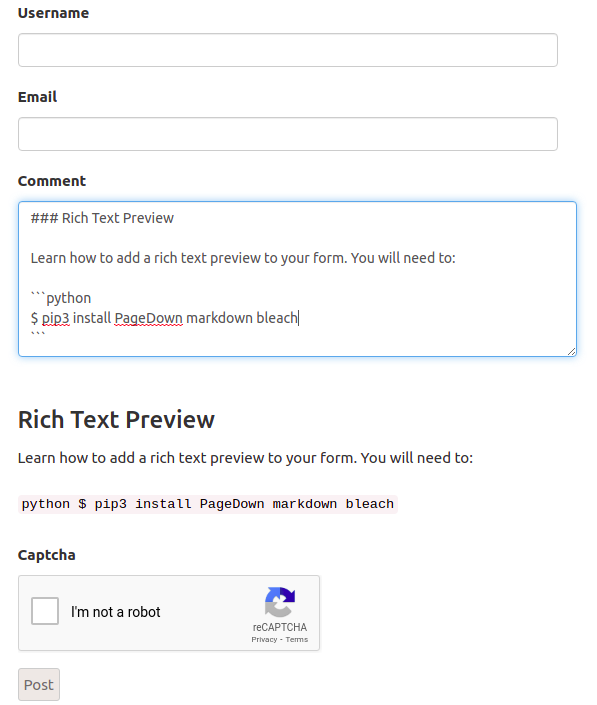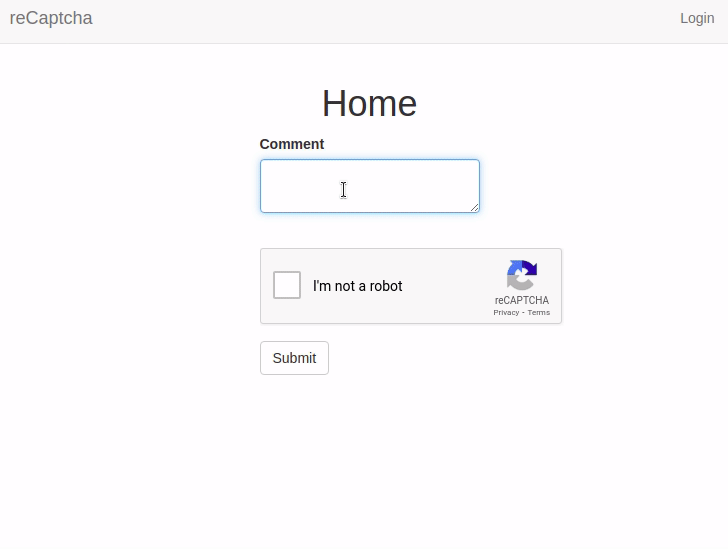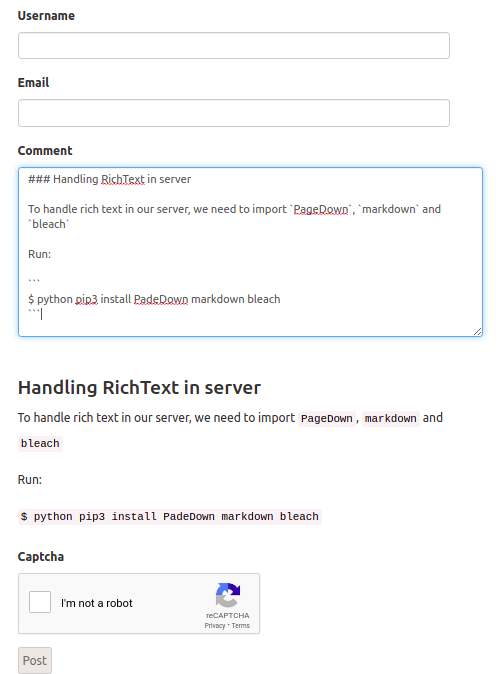Handling Rich Text in Flask
If you have been to Stack Overflow, and at one point asked or answered a question, you have probably noticed that the form used allows for markdown editing, which has a nice preview at the bottom.

You can achieve this same feature in your Flask web app. Below, you will learn how to integrate markdown preview on the client side and also how to handle rich text in the server.
Create Your Form
Since we want to have the ability to edit a post or comment in markdown, we will need to create a Flask form. If you are not aware of how to do this, check out how you can create one here.

Rich Text Client Preview
Richis a Python library for writing rich text (with color and style) to the terminal, and for displaying advanced content such as tables, markdown, and syntax highlighted code.
With our current form setup, there is no way that we can style our comment before it is posted. What we want to show users as they are typing their comments is something like this:

Welcome to Flask-PageDown
PageDown is the JavaScript Markdown
previewer used on Stack Overflow and all the other
question and answer sites in the Stack Exchange network.
Flask-PageDown provides a PageDownField class that extends
Flask-WTF with a specialized text
area field that renders an HTML preview of the Markdown text on the fly as you type.
We will make use of this package to add the rich text editor feature to our form. You can learn more from its documentatioin. We will begin by installing it in our virtual environment:
(venv)$ pip3 install flask-pagedown
Hoping that the installation was successful, the flask-pagedown extension needs to be instantiated in our application instance:
app/__init__.py: Register pagedown extension
from flask_pagedown import PageDown app = Flask(__name__) pagedown = PageDown(app)
The Editor is supported through two Javascript files. To include these files in your HTML document, you will need to call pagedown.html_head() from inside the <head> element of your page:
app/templates/base.html: Include pagedown in template
{% block head %}
{{ super() }}
{{ pagedown.html_head() }}
{% endblock %}
The Javascript files are loaded from a CDN, meaning the files do not need to be hosted by your application.
Update Form with PageDownField
The extention exports a PagDownField which is very similar to and works exactly as TextAreaField:
app/forms.py: Create form
from flask_wtf import FlaskForm from flask_pagedown.fields import PageDownField #<---------------New from wtforms import SubmitField class CommentForm(FlaskForm): comment = PageDownField('Comment', validators=[DataRequired()]) #<----------Edited recaptcha = RecaptchaField('Captcha') submit = SubmitField('Post')
That's it! You should be able to have a client-side comment preview right below the Comment box.

Handling Rich Text in the Server
If you have been following the tutorial on how to add Google reCaptcha to a web form, you will notice that the application does not work with a database yet. For this tutorial, however, we need to update the application to begin working with one.
First, we need to install the flask-sqlalchemy extension:
(venv)$ pip3 install flask-sqlalchemy
Then, we need to add the db variable to our application instance:
app/__init__.py: Add database variable
# ... from flask_sqlalchemy import SQLAlchemy # ... db = SQLAlchemy(app)
The application expects certain configuration variables to be set in the config.py file. Add the following to the config module:
config.py: Add database configuration
# ... basedir = os.path.abspath(os.path.dirname(__file__)) class Config(object): # ... SQLALCHEMY_DATABASE_URI = os.environ.get('DATABASE_URL') or \ 'sqlite:///' + os.path.join(basedir, 'app.db') SQLALCHEMY_TRACK_MODIFICATIONS = False
Create a Model
The model we would like to create will be a Comment model. This model will have the body and the timestamp fields:
app/models.py: Comment model
from app import db class Comment(db.Model): id = db.Column(db.Integer, primary_key=True) body = db.Column(db.Text) timestamp = db.Column(db.DateTime, index=True, default=datetime.utcnow) def __repr__(self): return f'Comment: {self.body}'
With the Comment model defined, we can now create the database by applying the changes we have just made. In your terminal, run the commands below:
(venv)$ flask db init (venv)$ flask db migrate -m 'comment table' (venv)$ flask db upgrade
You will notice that a migrations folder will be created as soon as you run flask db init. This folder will hold all the migration scripts that the application will be using. flask db migrate creates a new migration script, and flask db upgrade applies the changes made.
Note that for you to use the flask command, you need to have initialized the environment variable FLASK_APP to point to the test.py file.
When the form is submitted, only the raw Markdown text is sent with the POST request; the HTML preview that is shown on the page is discarded. Sending the generated HTML preview is a security risk as an attacker can easily construct HTML sequences which don't match the markdown source and submit them. To avoid any risks, only the Markdown source text is submitted, and once in the server it is converted again to HTML using Markdown, a Python Markdown-to-HTML converter.
There are two more extensions that we can use to help us achieve this. Go ahead and install them:
(venv)$ pip3 install markdown bleach
bleach allows us to sanitize the resulting HTML to ensure that only a few HTML tags are allowed.
Comment conversion can be done in the _comments.html subtemplate, but it is inefficient to do it here as all comments will have to be converted every time they are rendered to a page. We get rid of this repetition by making the conversion when the data is in our database.
The HTML code for the rendered blog post is cached in a new field added to the Comment model that the template can access directly. The original Markdown source is also kept in the database in case the post needs to be edited.
Update the Comment Table
First, we need to add a html field to the table. We can do this by adding the following to the Comment model:
app/models.py: Add html field
import bleach from markdown import markdown class Comment(db.Model): id = db.Column(db.Integer, primary_key=True) body = db.Column(db.String(140)) body_html = db.Column(db.String(140)) # <----------------------------------- new timestamp = db.Column(db.DateTime, index=True, default=datetime.utcnow) # new function @staticmethod def on_changed_body(target, value, oldvalue, initiator): allowed_tags = ['a', 'abbr', 'acronym', 'b', 'blockquote', 'code', 'em', 'i', 'li', 'ol', 'pre', 'strong', 'ul', 'h1', 'h2', 'h3', 'p'] target.body_html = bleach.linkify(bleach.clean( markdown(value, output_format='html'), tags=allowed_tags, strip=True)) def __repr__(self): return '<Post {}>'.format(self.body) db.event.listen(Comment.body, 'set', Comment.on_changed_body) # <------------------new
The on_changed_body() function is registered as a listener of SQLAlchemy’s “set” event for body , which means that it will be automatically invoked whenever the body field is set to a new value. The handler function renders the HTML version of the body and stores it in body_html , effectively making the conversion of the Markdown text to HTML fully automatic.
The actual conversion is done in 3 steps:
markdown()function does an initial conversion to HTML. The result is passed toclean()function with a list of approved HTML tagsclean()function removes any tags that are not in the whitelist.linkify()function frombleachconverts any URLs written in plain text into proper<a>links. Automatic link generation is not officially in the Markdown specification, but is a very convenient feature. On the client side, PageDown supports this feature as an optional extension, so linkify() matches that functionality on the server.
After these changes, we need to apply them to our database:
(venv)$ flask db migrate -m 'Add new field to Comment table' (venv)$ flask db upgrade
The route handling this request needs to be updated to retrieve all the comments in the Comment model.
app/routes.py: Retrieve all comments
# ... @app.route('/', methods=['GET', 'POST']) def index(): form = CommentForm() if form.validate_on_submit(): comment = Comment(body=form.body.data) db.session.add(comment) db.session.commit() flash('Your comment has been published.') return redirect(url_for('index')) page = request.args.get('page', 1, type=int) posts = Comment.query.order_by(Comment.timestamp.desc()).paginate( page, app.config['POSTS_PER_PAGE'], False) next_url = url_for('index', page=posts.next_num) \ if posts.has_next else None prev_url = url_for('index', page=posts.prev_num) \ if posts.has_prev else None return render_template( 'index.html', title='Home', posts=posts.items, next_url=next_url, prev_url=prev_url )
With our database updated, we will now replace comment.body with comment.body_html in the template when available:
app/templates/index.html: Use HTML version in post body
<div class="row"> <div class='col-sm-12'> {% for post in posts %} {% if post.body_html %} {{ post.body_html | safe }} {% else %} {{ post.body }} {% endif %} {% endfor %} </div> </div> <!-- Pagination of comments --> <nav aria-label="..."> <ul class="pager"> <li class="previous{% if not prev_url %} disabled{% endif %}"> <a href="{{ prev_url or '#' }}"> <span aria-hidden="true"><</span> Newer posts </a> </li> <li class="next{% if not next_url %} disabled{% endif %}"> <a href="{{ next_url or '#' }}"> Older posts <span aria-hidden="true">></span> </a> </li> </ul> </nav> <!-- End of pagination of comments -->
The | safe suffix when rendering the HTML body is there to tell Jinja2 not to escape the HTML elements. Jinja2 escapes all template variables by default as a security measure, but the Markdown-generated HTML was generated by the server, so it is safe to render directly as HTML.
Reload your page and try to post a new comment with markdown syntax:

Update Project Dependencies
Ensure you update your project requirements:
(venv)$ pip3 freeze > requirements.txt
Share
If you enjoyed this article, you can share it with another person.
TweetNewsletter Subcription
Level up your skills.
We take your privacy seriously. Read our privacy policy. Unsubscribe | Resubscribe.Comments (2)
|
|
#1
PyBoy
said :
|
|
|
#2
gitauharrison
said :
@PyBoy, thank you for pointing that out. |






Thanks for this, I really enjoyed this article.
Just a note, in your last image of a demonstration,
PageDownis misspelled asPadeDown.